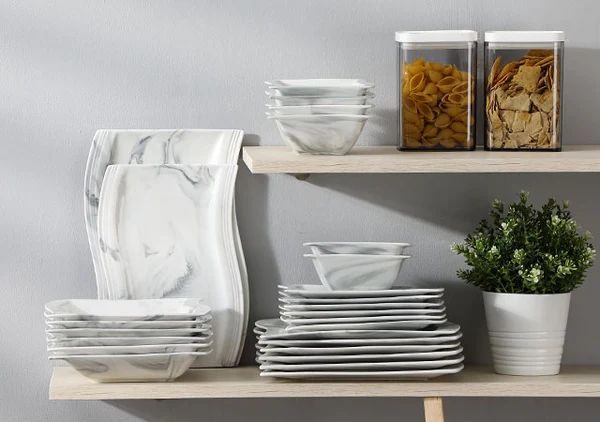Can You Cook With Porcelain In The Oven?
Cooking and baking with porcelain can be a fun and creative way to make delicious meals. However, porcelain requires special care and handling compared to other cookware materials. In this article, we’ll explore what porcelain bakeware is, its advantages and disadvantages, safety tips for use, what to cook in porcelain pans, and how to properly care for porcelain to extend its lifetime.
Porcelain’s smooth nonstick surface makes it a joy for baking cakes, cookies, and breads that slide right out of the pan. Its heat retention properties also allow for even cooking results. However, porcelain can be prone to chipping and cracking under certain conditions. Understanding proper usage guidelines helps ensure your beautiful porcelain pans remain protected.
Read on to learn everything you need to confidently cook and bake with porcelain cookware.
What is Porcelain?
Porcelain is a ceramic material made by heating raw materials, usually including kaolin, a fine white clay, in a kiln to temperatures between 1,200°C and 1,400°C as described in this Wikipedia article. The resulting material is non-porous, hard, durable, and can be molded into various shapes while still soft, making it ideal for tableware, art objects, and a wide range of industrial applications.
Porcelain has several key properties that distinguish it from other types of pottery and ceramics:
- Non-porous – Porcelain is impermeable to water due to its vitrified, glass-like body after firing in the kiln.
- Durable – Its high strength allows porcelain to be used in a wide range of functional and decorative objects.
- Heat resistant – Porcelain can withstand very high temperatures making it ideal for baking and cooking.
Types of Porcelain Cookware
There are three main types of porcelain cookware: bakeware, tableware, and pots and pans.
Bakeware refers to dishes made for oven use, including:[1]
- Casserole dishes
- Pie plates
- Cake pans
Porcelain bakeware can withstand very high oven temperatures, making it ideal for baking and roasting. The smooth, nonstick surface allows food to release easily.
Tableware includes porcelain plates, cups, bowls, and other serving pieces used for dining. Porcelain tableware is durable and stain resistant. The elegant, smooth surface gives it a refined, upscale look.
Pots and pans made from porcelain enamel coated metal are a popular option. Unlike traditional nonstick pans, porcelain enamel provides a naturally slick cooking surface that is also nontoxic. Porcelain enamel pots and pans can be used on both the stovetop and in the oven.[2]
Benefits of Cooking with Porcelain
There are several key benefits to using porcelain cookware that make it a popular choice in many kitchens:
Even heating: Porcelain distributes heat evenly and efficiently throughout the pan. This prevents hot spots that can lead to burning food. Porcelain’s smooth nonstick surface allows food to cook and brown evenly as well (1).
Doesn’t react with foods: Porcelain has a nonreactive glazing that prevents acids, salts, and alkalis in foods from interacting with the cookware material. This helps maintain true flavors and colors of food without metallic or chemical transfers (2).
Easy to clean: Grease and stuck-on food wipe away easily from porcelain’s smooth interior. It can be conveniently cleaned by hand or in the dishwasher. Avoid abrasive cleaners that could damage the enamel coating (1).
Sources:
(1) https://www.dishesonly.com/blogs/news/porcelain-enamel-cookware
(2) https://www.leafscore.com/eco-friendly-kitchen-products/pros-and-cons-of-porcelain-enamel-cookware/
Safety Tips for Cooking with Porcelain
Porcelain cookware is generally quite durable, but there are a few precautions to take when cooking with porcelain to ensure safe use:
Avoid sudden temperature changes. Do not put a hot porcelain dish straight into cold water or place it on a cold surface. Allow it to cool gradually to prevent cracking or crazing. Slow heating and cooling is best.
Use padded gloves when handling hot dishes. Porcelain conducts heat very well, so use care when removing hot pans from the oven or stovetop.
Check for hairline cracks before each use. Carefully inspect porcelain pieces to make sure there are no small cracks in the glaze. Cracks can allow bacteria to grow and chemicals to leach into food over time.
Preheat properly. Always preheat your oven fully before adding porcelain bakeware. This prevents thermal shock from sudden temp changes.
Avoid metal utensils. Use wooden or silicone utensils when cooking in porcelain pans to prevent scratching the enamel surface.
Clean with care. Gently hand wash porcelain in warm, soapy water. Avoid abrasive scouring pads.
Use oven mitts. Always grab hot porcelain pans and lids securely with well-insulated oven mitts or potholders.
Allow pans to cool before adding cold foods. Do not add cold ingredients to hot porcelain pans. Let them cool down closer to room temp first.
Avoid drastic temp changes. Do not plunge hot porcelain into an ice bath or run cold water over it. Let it cool slowly.
What Foods to Cook in Porcelain
Porcelain bakeware is excellent for baking and cooking a variety of dishes in the oven. Here are some of the best foods to cook in porcelain:
Casseroles, stews, and soups: The even heat distribution of porcelain is ideal for casseroles, stews, and soups. Porcelain cookware can go from stovetop to oven easily for simmering, braising and baking these dishes.
Pies, breads, and cakes: Porcelain’s nonstick surface makes it great for baking sweet treats like pies, breads, and cakes. Porcelain allows even browning without sticking.
Rice, grains, and beans: Porcelain excels at gently cooking rice, grains, beans, and other side dishes without scorching or burning. The smooth interior helps prevent sticking and allows easy cleaning.
What Not to Cook in Porcelain
While porcelain enamel cookware is versatile, durable and safe for most cooking applications, there are some types of food that should be avoided when cooking in porcelain.
One of the biggest things not to cook in porcelain is highly acidic foods like tomatoes or tomato sauce. The acidity in tomatoes can react with the porcelain glaze and cause discoloration or enamel damage over time (Source). It’s best to use stainless steel or enameled cast iron when cooking tomato-based dishes.
You’ll also want to avoid cooking very dry or fried foods in porcelain. Letting food get too dry can allow it to stick and stain the enamel. Frying at high temperatures may also damage the glaze. For fried foods, nonstick or well-seasoned cast iron are better options (Source).
In general, avoid cooking anything too acidic, sugary, or starchy in porcelain as these can react with the enamel over time. Stick to cooking moist foods like soups, braises and steamed dishes to get the most out of your porcelain cookware.
Caring for Porcelain Bakeware
When it comes to caring for porcelain bakeware, there are a few key tips to keep in mind. First and foremost, porcelain should always be handwashed to avoid damaging the delicate material in a dishwasher. According to Madeincookware.com, handwashing porcelain allows you to gently clean without subjecting it to the harsh environment of a dishwasher.
You’ll also want to avoid using abrasive cleaners or scrubbers when washing porcelain, as they can scratch or damage the surface. Instead, wash porcelain with warm, soapy water and a soft sponge or cloth. For stuck-on food, you can let it soak for a bit before gently scrubbing.
Proper storage is also key for caring for porcelain bakeware. Avoid stacking items which could lead to chipping or cracking. Store porcelain carefully on open shelves or in cabinets using parchment paper or towels between items to prevent contact.
Signs Your Porcelain is Damaged
Over time and with heavy use, porcelain bakeware can become damaged. Here are some signs to look out for:
Discolored glaze – If you notice the glaze changing color or turning gray, this could indicate damage to the porcelain. The glaze protects the pot or pan, so discoloration often precedes cracking or chipping.
Small cracks – Tiny cracks in the glaze may start to form, particularly around the rims or base. These can spread over time and lead to further damage.
Crazing marks – This refers to spiderweb-like cracks in the glaze. They may start very fine and small. Crazing indicates the glaze is compromised and moisture is seeping in, which can cause more extensive damage.
If you notice any of these warning signs, it’s best to stop using the damaged cookware. Porcelain with cracks or crazing can harbor bacteria and may not be food safe. At that point, it’s usually not possible to repair porcelain bakeware. Instead, it will need to be replaced. Be sure to inspect your porcelain pans and dishes regularly to catch any issues early.
Conclusion
In summary, porcelain offers an attractive and durable option for ovenware and bakeware. Its low porosity makes it an ideal choice for moist foods like casseroles and custards. Porcelain can safely withstand high oven temperatures, allowing you to roast, bake, and broil. While more delicate than stoneware, porcelain holds up well with proper care. Avoid sudden temperature changes and direct stovetop heat. Check for small cracks and discarded chipped or damaged pieces. With sensible precautions, porcelain cookware can provide many years of beauty and enjoyment in the kitchen.
Cooking with porcelain can add elegance and versatility to your oven meals. From baking casseroles to roasting vegetables, porcelain performance matches its classic style. Treat your porcelain pieces with care for lasting, dependable service. Follow the manufacturer’s recommendations and your own good judgment to maximize the convenience and durability of porcelain ovenware.




